by Mark Freburg
The Dream
For a long time I thought that if I could ONLY have one revolver for self-defense it would be the Ruger Redhawk with a short barrel around 4 or 4.5". The large service-style stocks fit my hand really well, and in that big pistol even the .44 Magnum was comfortable to shoot. In my youth and middle-age I would have been happy with the .44 Magnum chambering because that was a do-everything cartridge, and I believed that practice made perfect, which we know is true--as long as it is perfect practice. And I shot .44 Magnums, very rarely reverting to the .44 Special loads that it seems many use instead in their magnum-chambered revolvers. To me it seemed that if you were going to carry all that steel, it made sense to use the cartridge it was made to shoot. That still makes sense to me.
I owned a 7.5" Redhawk as early as 1983 and loved it, but the 7.5" barrel was all wrong for defensive use. Ruger never offered a short barrel in those days, however, so the only option was someone like gunsmith Hamilton Bowen, the revolver genius. I couldn't handle the customizing cost. The Redhawk went, as did a twin I later owned.
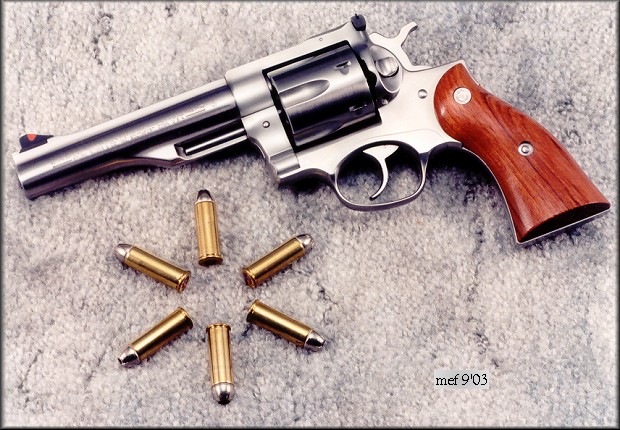
When the Colt Anaconda came along in 1990 and could be had with a 4" barrel I jumped on it as soon as I could, probably around 91 or so. It looked really strong and I thought it could be my dream, do-it-all wheelgun. As it turns out this was in the early days of sintered metal parts for Colt, Smith & Wesson, and others, and then too, a lot of the small parts were only surface hardened as well. Not exactly a recipe for durability. Nevertheless, I shot it a good bit and handloaded for it carefully, developing very accurate loads.
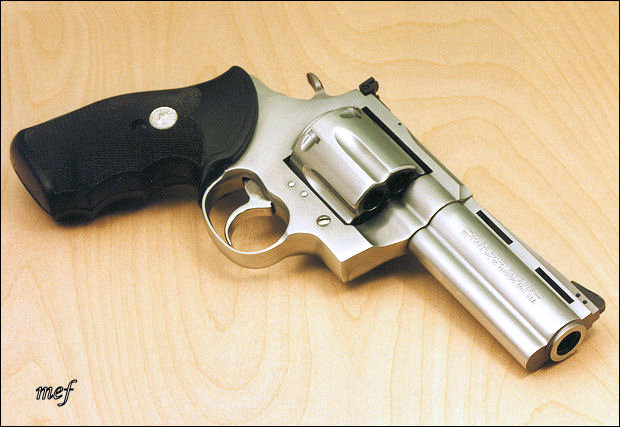
The action wasn't great out of the box, however, and I went through it carefully with files--very carefully due to the action parts being only surface hardened. This meant because I had to take ultra-care not to break through surface-hardened small parts, I couldn't get quite as much smoothing as I wanted. In those days parts were not finely CNC produced. But my results were better than a factory Colt.
The other issue was that the DA trigger reach was a bit excessive for my hands. In DA use I actually rolled my strong hand around to the right and did better than okay, but this is not ideal. The only shooter I really respected a lot was my friend Kim, now a retired federal law enforcement and firearms trainer, also of this forum. He paid me high compliments for my DA revolver shooting using this Anaconda, so my hours of practice were paying off, I knew that, but as to the ideal revolver, the Colt wasn't it. No one made stocks that fixed the reach problem, and of course I was raised right with DA revolvers and I fired them DA-only at speed. SA was for deliberate shots, which meant almost never, and for me, for load development only. I got some laminated wood stocks with finger grooves, ground them off with a bench grinder because the epoxy resists files like crazy, and started grinding the overall size down, but without being able to use precision tools (files and sandpaper), it was a project doomed to fail for me. Plus, the hardness of the gripping surface meant exacerbated recoil. In the end I sold the Colt.
I went through the aforementioned second Redhawk after that, no dice. Still couldn't pull the trigger on custom work. So, some years later I acquired a Smith & Wesson 629 Mountain Gun and put some Eagle, Roper-style wood stocks on it. Really beautiful:
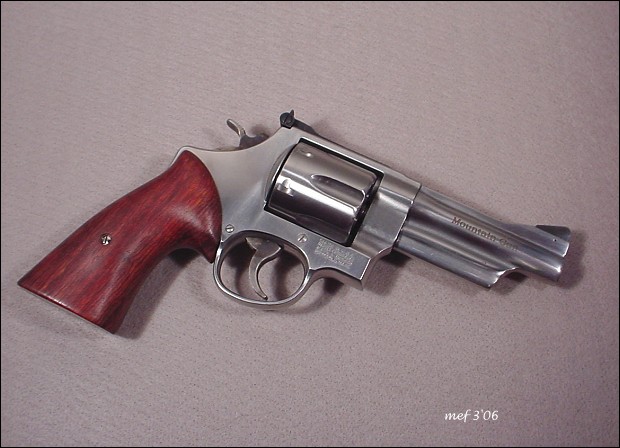
But the first time I shot it with magnums I about broke my hand. I finished the cylinder in great pain. Yes, I can be really stupid--determinedly stupid. It really made me disappointed with the gun as I thought it might be the perfect defense revolver despite the stupid lock, recently adopted by S&W in a fit of lawyer-like safety paranoia. So I bought some Pachmayr Gripper Decelerators, which are the softest rubber stocks made, and it really tamed the 629. But the much-added girth at the backstrap made the DA trigger reach an issue. Shades of the Anaconda. Not terrible but not right. And geez, I really hate soft rubber grips on self-defense handguns. Just look dumb to my eye on a carry gun, but mostly they stick to clothes. I was already ticked off because of my nearly broken hand--of course it was my fault--but nevertheless, I was not feeling favorable toward the gun, I hated the stupid lock, so I traded it and took a huge loss, really huge. It was essentially new.
And not long after Ruger did release a 4.5" barrel Redhawk, but it had cheesy fingergrooves on the stocks, and they didn't fit me. The front sight which used to have interchangeable posts was now a pin-on and not amenable to changing from the red insert I didn't like1, and I basically felt that Ruger crapped-up a previously great revolver, as gun companies are wont to do. Being picky about one's guns is both a blessing and a curse.
The Epiphany
Well, maybe not an epiphany, but that sounds better than "oh d'uh..." Some time after that, I realized a .44 Magnum is not the one revolver, at least it isn't for everyone, and for an older and (please, God) wiser me, not me anymore either. I have finally understood that one doesn't shoot .44 Magnums forever if they have ordinary sensibilities, especially in regard to recoil and shot to shot recovery. Anything I need in a true defensive revolver can most certainly be achieved with something other than a 44 Remington Magnum cartridge. So where does that leave a fellow who still thinks there is a lot to be said for one DA revolver for self-defense? You probably know the answer. But we'll take the long way.
No, it wasn't the Ruger Redhawk .45 Colt/.45ACP, much as that made a few .45 guys happy. I am a .45 guy, but I'm also a 1911 guy, and that's where I shoot .45 ACP. I've never shot .45 Colt (great round, just one of the very few popular handgun rounds I don't do, and I have no need to add it to my collection at this stage. Plus I really dislike convertible handguns. I know they are popular, but I really don't get it. If I want to shoot two calibers I'll purchase two guns. To my way of thinking, a jack of all trades is a master of none, and that includes convertible handguns. That to me is a no-brainer.) Nope, the new answer to my all-around revolver once I got too feeble for the .44 Magnum was simple.
It's a .357 Magnum revolver. And if it is going to be tough enough for everything over the long haul it is going to be a good size revolver. You know those ridiculous (truly, completely, absurd) little J-frame and SP101 magnums aren't in the conversation. We won't dignify them by listing the dozens of reasons why not. If you own one go away and hang your head. I paid penance for all the silliness I did surrounding my 629 Mountain Gun, now it's your turn to be embarrassed for even owning a J-frame magnum. And don't say you shoot .38s in it. It won't wash--we've discussed the stupidity of owning a magnum and shooting specials. Sheesh.
We do, however, need to address the medium-frame .357 revolvers briefly, though they are not the answer, either. The medium-frame magnum, as embodied by the S&W Models 19 & 66, as well as the long-gone Ruger Security-six (a nice example is shown below this paragraph) and the long-lived Taurus Model 65, is shootable. It takes practice to shoot them well, and many if not most wear rubber stocks. But then they are mostly belt guns, were often uniform police and then later security guard guns, and rubber stocks don't matter. Also, truth be told, users carried or were issued .38 Special ammo as often as not, which of course these handled perfectly and without much recoil. But these aren't for me2, or anyone wanting the ultimate .357 revolver. The biggest reason is that most of them will not take a lifetime's pounding from the hottest .357 Magnum ammo. (The Ruger Security-six might, but it has been out of production since before most of today's shooters were born, so we really can't consider it:
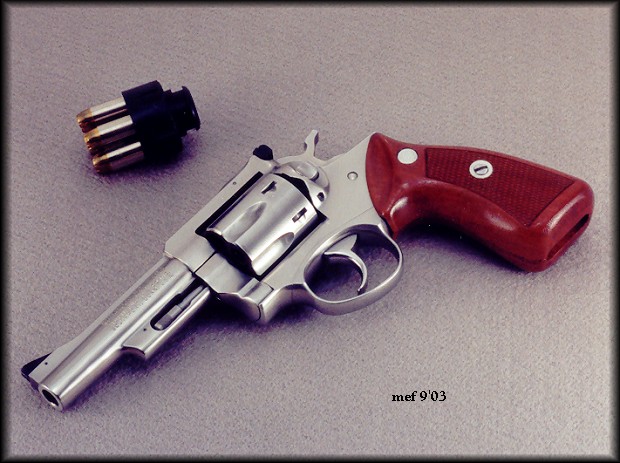
For an all-around revolver we need a medium-large frame, also called by some companies an intermediate frame. Let's stick with "medium-large." They lay in between the medium frame like the S&W K-frame and the large frame such as the S&W N-frame or Redhawk. What models do we have? We have two in print worthy of consideration. One is the 30-year-old S&W L-frame, originally four models, now whittled down to one, the Model 686 (sometimes offered in the blue 586 as a reborn Classic offering). The other is the 25-year-old Ruger GP100, still offered in stainless or blue, mostly with adjustable sights but sometimes with a shorter barrel and fixed sights, although that one is normally chambered in .38 Special and of absolutely no interest to us here.
Point of fact, there was the Colt E/I-frame, which evolved through many permutations of frame names and model names, ending up as the Colt King Cobra, and this is also a medium-large frame competitor, though long since discontinued. Those who only watch new releases may be aware of the new "King Cobra," but that one is a whole new revolver, built on the smaller D-frame (think Detective Special), with fixed sights, in .38 Special, and not at all in the same conversation. While the original King Cobra was a big, strong revolver, and while I strongly suspect it would be among the most accurate (based on my experience owning its large .44 caliber brother from the same era), Colts of the day were still using sintered metal parts, not my favorite kind of metal parts. If I hadn't dropped a different model Colt of the same era on a carpeted floor one day and had a part break in half upon hitting the carpet, I'd be less skeptical, perhaps. I might consider the original King Cobra if I still owned one, but I would not scour used guns today looking for one. Those were not the best days for Colt.
How about offerings from Taurus? I don't know exactly what Taurus offers today, their model line is quite varied, but personally, I don't care. I do own one very nice small Taurus revolver, but I've owned several that have gone bye-bye. Taurus has a bad tendency to release too many revolvers that show poor quality control among the ones that are first rate. It's a risk I no longer care to take when looking for a solid working gun. And that's the end of my conversation on Taurus.
And we're back to two. The S&W 686 is a perfectly suitable medium-large frame .357 Magnum revolver:
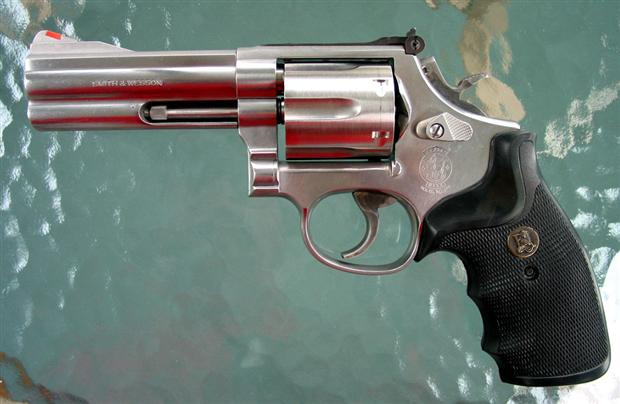
It's certainly proved itself over the years in most fields. In modern times it has been offered in increased capacity cylinder versions, too, which appeals to many. Nevertheless, it isn't my choice, and here you'll have to accept personal preference and a little prejudice. I like S&W revolvers fine, have been issued them, and own a couple. I know most people believe S&Ws have the best revolver triggers. I've always liked Colt triggers, but overall I prefer Ruger DA revolvers. It's simply a preference I developed very early on--after, I should mention, four years of being issued a Smith & Wesson. I studied them all, and when I had to buy one for duty, I bought a Ruger, believing it the safest and the most rugged. My preference.
So--my choice for one revolver for all-around self-defense is the Ruger GP100 with a four inch barrel. (Ruger calls this 4.2", and that's probably accurate.)
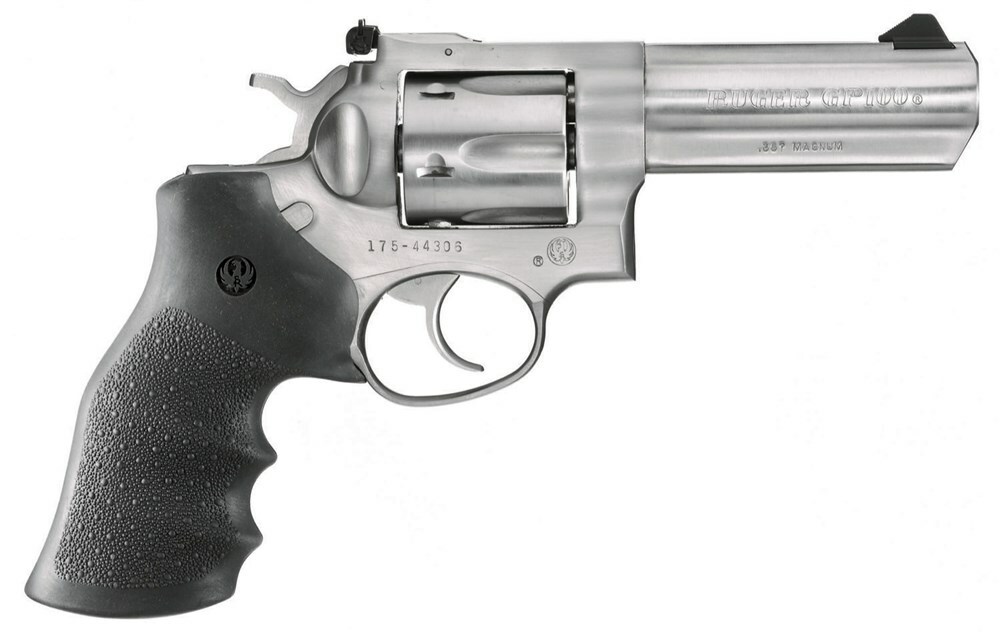
Currently offered Ruger GP100 with 4" barrel and Hogue Grips
I believe that in the long run the Ruger is FAR easier to maintain than the S&W, and stronger. I much prefer the original rubber-with-walnut insert Lett Grips that used to be standard on the GP100 before Ruger began using Hogue Grips, which I personally detest. The Hogues either fit you or they really don't fit you. Hogues really don't fit me, thus my opinion.
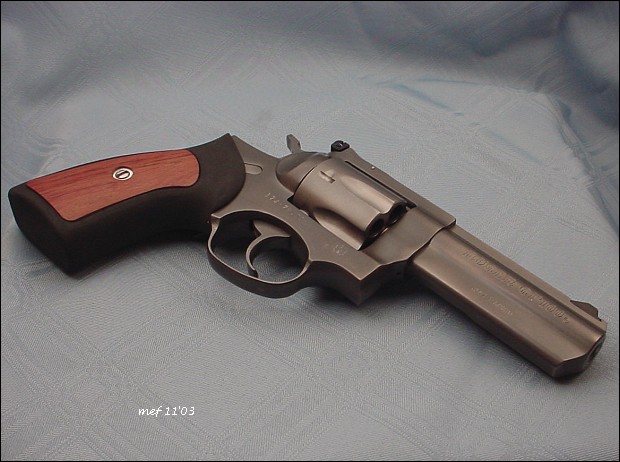 My own GP100 with Target Grey stainless finish and factory Lett Grips
My own GP100 with Target Grey stainless finish and factory Lett Grips
Lett Grips was supposed to have gone out of business--years ago now--but Ruger is now offering perhaps half a dozen or more models with what look like the old Lett Grips rubber grips with wood inserts, so someone is making them again. A major advantage of the GP100 is that it just has a grip stud rather than a full-on frame like a Smith, and any reasonable stock shape can be made for it, so you can make "square butt" or "round butt" grips that will both fit the same grip stud--no S&W style frame to worry about. The original Letts came in two sizes, essentially a smaller, "round butt frame" size and larger, "square butt frame" size, as shown below.
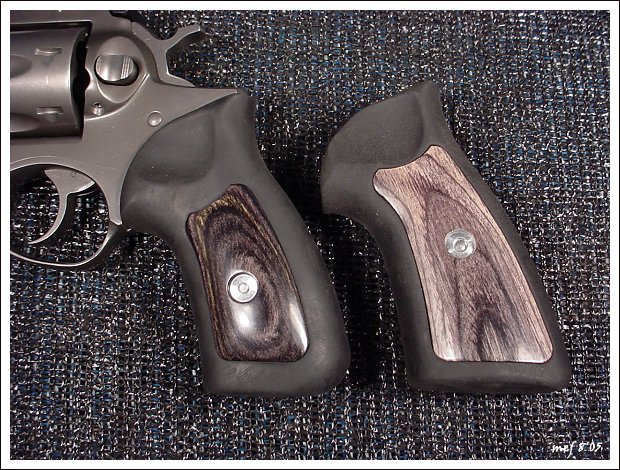 Original Lett Grips in round (left) and square butt (right) sizes with Lett inserts in laminated black/silver
Original Lett Grips in round (left) and square butt (right) sizes with Lett inserts in laminated black/silver
Of course any number of aftermarket stocks are also available for the GP100 after 25 years on the market. But the larger size fits most hands, and the smaller size fits just about anyone. The GP100 is large but not over-large nor too heavy. It eats up magnum recoil and doesn't tire the shooter. For years I've used the once famous .357 Magnum 125gr. JHP, specifically the Remington scallop jacket SJHP load at 1450fps out of a four inch barrel, now sold as a the RTP357M1 High Terminal Performance load. In a medium-frame revolver this is a serious handful, in my GP100 this is very controllable, and with the old-style Lett Grips, it is very comfortable to shoot. This revolver weighs almost exactly the same as a full-size 1911, a pistol I carry everyday.
A note here--the GP100 also comes in plus-capacity versions now, same as the Smith & Wesson, in checking with Ruger I note the weight of the revolvers is the same 40oz. either way. I'm conditioned to the six-shooter and would probably stay with the one I've owned for many years, but if you were just starting out, the seven-shooter might be a good choice, as long as speed loaders and pouches are available. I haven't looked.
I don't think carrying this revolver would be an issue, though most people would prefer to carry OWB rather than IWB due to the girth of the cylinder. I have a very nice Don Hume leather holster for mine. A DA revolver is going to be a special choice for anyone that chooses one regardless, but there are options, and there are circumstances where I can see the revolver being the best of all worlds, especially if one is an outdoorsman and lives in the outdoors for the most part. If I lived in the country and rarely ventured into town I could easily imagine wearing an openly carried DA revolver on a daily basis, and my Ruger GP100 would be the gun I'd choose. But for everyday carry, or EDC as it's now termed, there are some very good IWB holsters (MASC holsters comes to mind), and with the right belt, this would be a viable option as well for those of you willing to think outside the box!
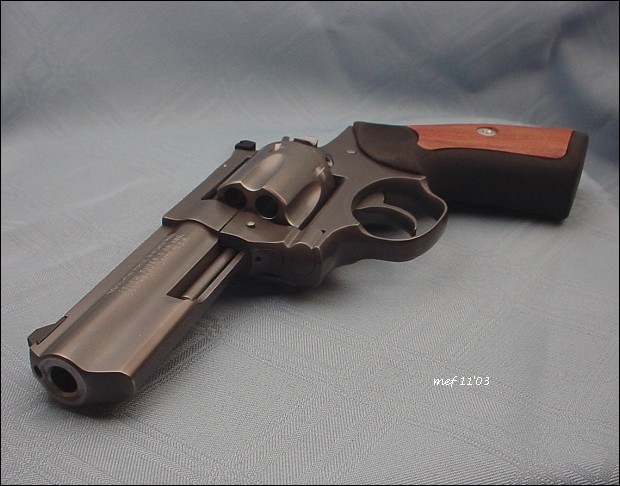
NOTES:
1 Of course years later Ruger saw the error of their ways and reverted to the easily replaced front sights on all factory Redhawks.
2 When I include the Security-six among the other medium-frame revolvers which are "not for me," I mean as the one revolver for self-defense. I own two Security-six revolvers and one Speed-six. I love shooting the Rugers and will never get rid of them.

Uploaded: 8/10/2019

